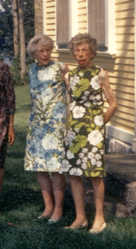(Page 2 of 2) Print Version
Madeleine "Bob" Burrage
Madeleine Burrage (1891-1976), known to family and friends as “Bob,” was born in Portland. The family including parents Ernestine Giddings and Henry Sweetser Burrage, and sister Mildred lived in Kennebunkport from 1912 to 1946.
The Burrage sisters' education included Abbott Academy and Miss Wheeler's School in Providence, Rhode Island. During World War II, Madeline taught in the metal shop—Mildred taught painting—to soldiers with severe burns at Halloran General Hospital on Staten Island, and in the skills program of the American Red Cross in New York. Colby College awarded Madeleine and Mildred honorary master of arts degrees in 1963.
Madeleine was a gemologist and jeweler who worked precious and semi-precious stones in gold and silver. During her lifetime, the Museum of Modern Art in New York, the Philadelphia Art Alliance, the Worcester Museum, the Boston Arts Festival, and the Jessup Memorial Library exhibited Madeleine Burrage's artwork.
Madeleine Burrage's Jewelry Art
Madeleine Burrage specialized in creating jewelry from Maine gems and minerals. She was a "rock hunter" who sought out and prepared stones including tourmaline, aquamarine, and agates for her jewelry.
Between September to November 1946, the Museum of Modern Art (MOMA) in New York exhibited five pieces of Madeleine Burrage's jewelry in "Modern Handmade Jewelry." The exhibition featured modern art luminaries like Alexander Calder and Anni Albers.
The MOMA press release noted the, "criterion of selection was simply: those designs which showed that the artist had considered the characteristics of the materials used and made us aware of their intrinsic beauty in contemporary terms."
Mildred Burrage's papers at the Maine Historical Society include items relating to Madeleine Burrage, especially since the sisters lived together most of their lives. The collection contains two volumes of inspirational scrapbooks created by Madeleine demonstrating her creative process, and the influence of contemporary fashion on her artwork.
The Burrage sisters were accomplished artists who supported each other. Mildred painted at least 35 montages of Madeleine’s work, perhaps as promotional material for her sister’s work. Mildred developed a technique in Mexico and Guatemala of underpainting her watercolors with white gesso—a canvas preparation artists normally use for oil and acrylic painting—and mixed gesso with her watercolor paints to accomplish gleaming and realistic jewel-like colors in the paintings.
Mildred and Madeleine Burrage traveled the world together. These photographs of Mildred and Madeline Burrage appeared on their passports and visas during visits to Mexico and Guatemala in 1935 and 1936, and the influences of these cultures are notable in Madeleine's artwork.
Mildred Giddings Burrage
Born in Portland, Mildred Burrage (1890-1983) began studying artwork at age twelve. She attended Miss Wheeler’s School in Rhode Island, which sponsored Mildred's first trip to France in 1909. Mildred studied and traveled intermittently in Europe until the onset of World War I. During WWII, she worked in the Liberty Ship yards in South Portland, and along with Madeleine, taught arts and crafts to soldiers with severe burn wounds, an early type of art therapy, at Halloran Hospital New York.
Mildred Burrage embraced new ideas, especially about art. While in France, she met Monet in Giverny, viewed some of the earliest exhibitions of Picasso and Matisse in Paris. Experiencing Jackson Pollock's expressionist works in New York inspired Burrage's move from representational paintings toward abstract work. Mildred noted in 1974, “It was not easy for me to change. I was frightened, I found. It seemed preposterous to stop copying nature but I kept on.”
The Burrage sisters worked to establish artist networks in Maine, organized exhibitions and seminars addressing the challenges of artists in a rural state, and supported the Maine crafts movement. In 1947, Mildred curated the first serious exhibition of Maine crafts.
After moving to Wiscasset with Madeleine in 1946, the Burrages' interest in historic preservation deepened. They helped establish the Lincoln County Cultural and Historical Association in 1954, and Mildred served as a representative of the National Trust for Historic Preservation in Maine.

Mildred Burrage's painted map of 1775 destroyed Falmouth Neck, 1925
Item Contributed by
Maine Historical Society
Mildred Burrage combined her interests of art and fashion when she created a linen handkerchief map of Washington, D.C. based on a 1792 map of the district.
President Franklin Delano Roosevelt’s uncle, Frederick A. Delano, collaborated with Mildred Burrage on the 1933 National Capitol Park and Planning Commission handkerchief project to raise funds for the construction of the George Washington Parkway between Mount Vernon and Great Falls, Virginia. Maine Historical Society holds a copy of the handkerchief map in the collections.
World War II Shipyard Fashion Show
In 1943, Mildred Burrage organized a fashion show at the New England Ship Building Corp. in South Portland. The show’s theme was, "What the Well-Dressed Women War Worker Wears." Burrage focused on fashion safety for women shipyard employees working in place of men fighting overseas during World War II. The shipyard staff worked in two shifts over 24 hours, and Mildred organized three fashion shows, saying "One sensed the weariness of the men and women working on the night shift, but they gave the girls a big hand."
In her report on the shipyard fashion show, Burrage referenced the American designer Mainbocher, who in addition to outfitting The Duchess of Windsor, Wallis Simpson, designed a series of uniforms for military and civilian organizations during World War II.
In addition to organizing the fashion show, Mildred painted posters for the shipyard promoting safety and proper work clothing with phrases and poetry she composed herself. One limerick highlighted the benefits of covering hair:
There was a young Tacker named Anna,
with curls not concealed by bandana,
Sparks got in her hair,
Burned out bits here and there –
Her boyfriend now goes out with Hannah.
The Burrage sisters lived together for most of their lives. Their bond extended after death, now buried side-by-side at Evergreen Cemetery in Portland.
Friendly URL: https://www.mainememory.net/exhibits/cosmopolitan_stylings


















